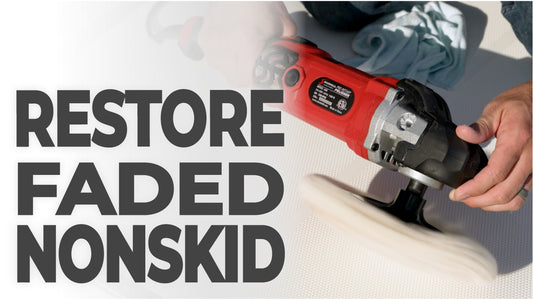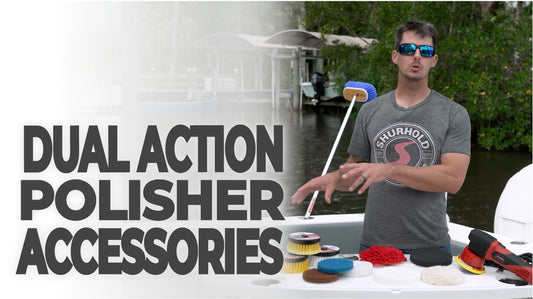How do you tell how badly oxidized your hull is? Rub the surface with a clean rag. If the chalky surface rubs off on to the rag, your gel coat is heavily oxidized.
Quick Video Tips
Check out these videos for quick tips related to this article.
Proper Waxing Technique
Proper Buffing Technique
Picking the Right Wax
Single Part Solutions
There are literally hundreds of different products on the market, all touting to be the best cure for dull, faded gel coat. One-part cleaner/wax products are a good place to start. These compounds are usually some form of wax combined with a very mild cleaner, a very mild abrasive compound and sometimes a lubricant. Applied with a buffer, they do a good job on mildly dulled or chalked finishes.
A step up, but still single part products are the restorer/wax compounds. These typically have a more aggressive rubbing compound than the cleaner/waxes. Some products claim to have an abrasive that continues to break down when being applied, producing a finer and finer finish.
Multi Part Solutions
There is another class of products touted to be the best solution for faded and chalky gel coat. These products are usually in the form of an acrylic or similar coating, much like floor wax. These liquids are very thin and easily applied. They quickly dry, leaving behind a waterproof coating that fills in the gel coat surface to form a shiny layer. Since the coating is very thin, multiple coats are usually required.
As with any treatment, the preparation is to properly clean the hull. These kits include cleaners and surface prep products as well as the finishing product. In worst cases, the manufacturer recommends a light sanding with 800 or 600 grit sandpaper to eliminate the chalking. These compounds are then usually applied by wiping on to the gel coat with an applicator pad or clean rag. This application is very easy, needing nothing like the skill required in painting, for example.
The downside to these products is that the coating will wear away or turn yellow. Depending on the conditions, I’ve heard terms from one to three years for the life of these finishes. In most cases, a yearly reapplication of several coats is suggested. After that, a total reapplication, using the manufacturer's cleaner, is needed. Again, the selling point is the ease of application and the instant shine achieved.
Polish and Wax
A mild abrasive compound is deemed a polish while abrasives that are more aggressive are called rubbing compounds. In this case, I’m talking about using one of those polishes and then a wax, not a combined product. Polishes are best applied with a buffer and a clean pad. I usually have several pads handy and change them out regularly as they become dirty.
Apply the polish and buff out until the gel coat color is uniform and glossy. Don’t buff at high speed or you risk overheating the surface. Once the color is uniform, apply a good quality paste wax for maximum protection and shine. Most paste waxes will last three to six months, so re-wax appropriately.
Compound, Polish and Wax
Compounding is usually the last process used, before giving up and repainting the boat. Rubbing compound comes in variations from mild to heavy-duty. It is usually applied to the surface and then buffed with a power buffer. Change pads often as they tend to get clogged with the rubbing compound and gel coat.
The results you are looking for are a uniform color and smooth satin finish. The more aggressive rubbing compound won’t produce a shine; the surface then has to be polished. The shine is brought out by using a polish. After polishing, an application of a good paste wax should result in an almost showroom new finish.



